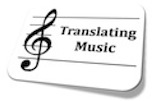17 September 2013: 3.00 - 5.00 pm, Imperial College, London, Blackett Building, Lecture Theatre 3.
Seminar 2: Making Music Accessible.
Scroll down for presentations
What’s Not To Hear?: Louise Fryer, Goldsmiths College, University of London, Presenter for BBC Radio 3 and Audio Describer
Making music accessible to blind and partially sighted people may sound like an unnecessary thing to do. Surely blind people can hear music? Leaving aside the issue that most blind people are elderly and may have additional disabilities including hearing loss, just think for a moment about elements of musical performance that sighted people take for granted. A poster for a classical concert or an advert in the newspaper catches your eye.
You head to the concert hall. You arrive and take in the grand façade of, say, the Royal Albert Hall. You spot a musician heading into the artists’ entrance. You mingle with other people in the foyer, collect a programme, skim through the notes about the pieces, the list of performers, photographs. You look towards the stage where a few players wander on. You are impressed by all the percussion – the tam-tam, the tubular bells. You note two harps, a celeste, a piano. More players drift on. It is a big orchestra.
There is an interesting gender balance. Most of the players are young. They are dressed in black suits not formal white tie and tails. They seem to have tracksuit tops over the backs of their chairs. The violins are split, the firsts on one side of the conductor, the seconds on the other. You notice the audience crushed at the front of the arena tense a little.
The lights dim in the auditorium and brighten on stage. The conductor bounds on, his hair a mop of dark curls that will in a few moments flop forwards, accentuating the downbeat of his baton. And that is just the start. Why should music need audio description? What’s not to hear?
Music to My Deaf Ears: Accessible Filmmaking and Music: Pablo Romero Fresco, University of Roehampton
For the past 30 years, subtitles for the deaf and hard of hearing have been providing hearing-impaired viewers all over the world with access to the sound of film and TV programmes, including what is said (the dialogue), how it is said (the tone and the mood), who says it (characters identification), the sounds effects and the music.
Of all these elements, music is undoubtedly the one that has been most neglected, perhaps because of the commonly held belief that music must be heard and felt, rather than read and understood, as seems to be the case in subtitled films. In some countries, subtitles for people with hearing loss don’t even include information about music.
>
What do hearing-impaired viewers think about the description of music in subtitles? How is this description provided in different countries? Does it make a difference to their enjoyment of film? Drawing on data obtained in the EU-funded DTV4ALL project and on a new initiative known as Accessible Filmmaking, which promotes the integration of translation and accessibility as part of the filmmaking process, this presentation looked at how music is subtitled across Europe, how viewers with hearing loss receive these descriptions and especially at what can be gained by fostering collaboration between translators and filmmakers to ensure that music is not just understood but also felt by viewers with hearing loss.
Captioning Musicals for deaf people: Alex Romeo, Freelance Surtitler (STAGETEXT)
How do we give deaf people the same experience as hearing people in the theatre using captioning? How can they make sense of music? This talk gave an overview of theatre captioning in the UK and discussed how captioners use conventions established with the help of deaf people who set up STAGETEXT to make every performance as accessible as possible.
It discussed different musicals that have been captioned over the last 10 years and used examples to illustrate the different methods captioners use to create their accessible script, focusing on issues relevant to making music meaningful to the deaf and the hard of hearing.
Listen Up! Raising Awareness of Opera Accessibility through Audience Reception Research: Sarah Weaver, Durham University
Opera is becoming an increasingly accessible art form for all including the blind and partially-sighted. Translation modalities for this audience including audio description, touch tours and Braille libretti continue to evolve according to constantly changing audience needs and expectations.
This paper discussed audience reception research into these methods and the crucial role these studies play in their development and in raising awareness of translation facilities to make opera universally accessible.
-----------------------------------------------------------------------------


